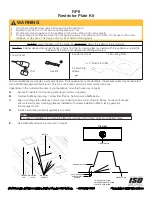
Console Software
48
Console Software
Note:
To preserve the high audio quality of the AudioFire 8 and AudioFire Pre8’s
converters it is best to use the
internal
input clock setting instead of synchronizing
to an external ADAT clock, which may add unwanted jitter to the signal.
S/PDIF
(AudioFire 2, AudioFire 4, AudioFire 8 and AudioFire Pre8) – The
Sony/Phillips Digital Interchange Format is a serial bit-stream that has a clock
signal embedded in the data stream. When recording from an S/PDIF source, your
AudioFire will utilize the synchronization clock that is embedded in the S/PDIF
while it decodes the bit-stream. Your AudioFire can only sync to S/PDIF clock if
the master device is set to a sample rate between 30kHz and 100kHz. Otherwise
you will get noise and/or loss of sync.
Note:
When synchronizing your AudioFire product to an external device via
S/PDIF, ADAT or Word Clock, you must set the AudioFire to the correct base
clock rate. See the following table for the correct base clock rate setting.
AudioFire 12 Only
External Clock Rate
30kHz – 50kHz 50kHz-100kHz
100kHz-200kHz
AudioFire Base
Clock Rate
44.1kHz or
48kHz
88.2kHz or
96kHz
176.4kHz or
192kHz
Now let’s take a look at some sample configurations and how you might set them
up from a synchronization standpoint.
Let’s start with a simple example. Suppose that AudioFire 8 is the only audio
device used in your system. Since you have no other devices to synchronize with,
simply select
Internal
for AudioFire 8’s input clock. AudioFire 8 will then use its
own clock to control its operation.
Now a little more complicated set-up: You want to have an AudioFire 8
synchronized to another device via word clock. Simply set the AudioFire 8 to
Internal
for its input clock. Now connect the AudioFire 8 to the other device via a
BNC cable running from Word Clock Out on the AudioFire 8 to Word Clock In on
















































